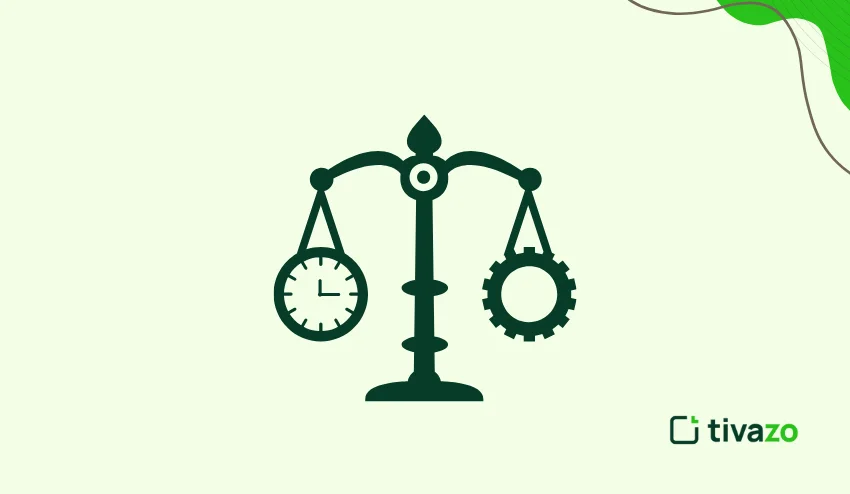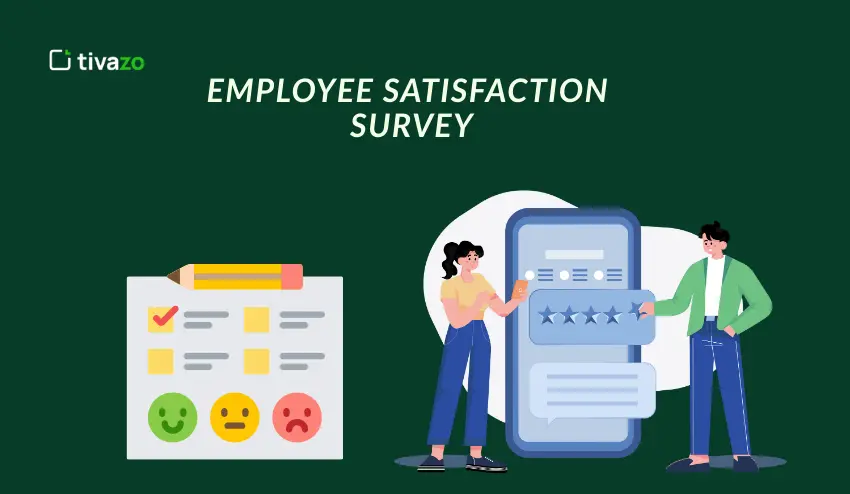Disciplinary Action procedures represent an essential component of sustaining a positive, efficient, and fair workplace environment. Whether you’re an HR professional, a team leader, or a company owner, recognizing how disciplinary procedures function can help safeguard your company culture, reduce conflict, and address employee misbehavior proactively and successfully.
This thorough article will explain what disciplinary procedures are, why they are important, the process, instances, common situations, and best practices used by leading HR professionals. We will also provide answers to commonly asked questions regarding disciplinary procedures to enhance your organization.
Throughout this post, consistent use of the focus keyword “disciplinary procedures” will help facilitate SEO.
What Are Disciplinary Procedures?
Disciplinary procedures are a systematic process that organizations implement to address disciplinary performance, misconduct, a breach of a company’s policy, or inappropriate workplace conduct. Disciplinary procedures do not exist to punish individuals, but instead define and re-educate minor rule-breaking, misconduct, or unacceptable behaviors, to positively change behavior, enhance performance, and/or maintain the integrity of the organization as a whole.
Organizations choose to implement disciplinary procedures to:
- Encourage fairness
- Implement policies
- Safeguard company culture
- Minimize liability
- Encourage accountability
- Establish improvement
Therefore, when applied seriously, disciplinary procedures become more of a method of correction than part of a punitive system.
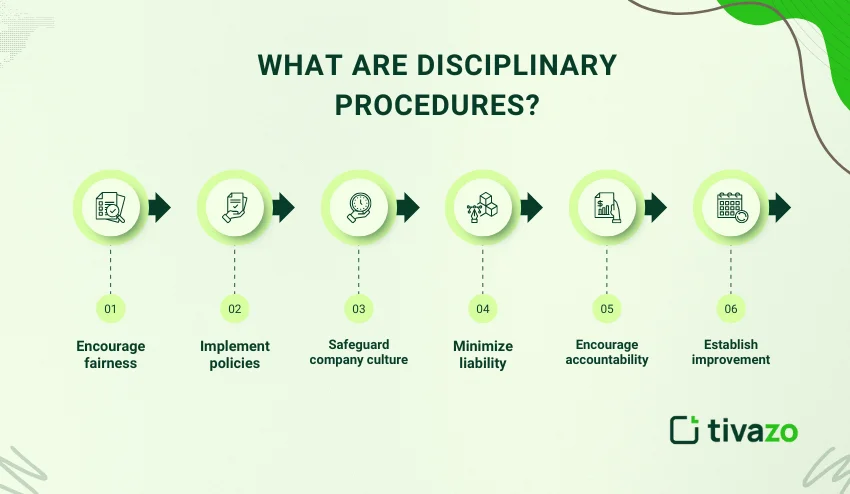
What is the Importance of Disciplinary Action?
Disciplinary action is vital to ensuring order and consistency in the workplace. Without having a proper disciplinary action process in place, employees may not comply with rules and policies, conflicts may escalate, and productivity may decline.
Here are the main benefits of taking disciplinary action:
- Reinforces and supports company values
- Minimizes negative behaviours
- Protects other employees
- Clarifies expectations and boundaries
- Contributes to decreasing turnover stemming from conflicts that are not managed
- Supports legal compliance in case of termination
Implementing a well-thought-out disciplinary action process increases trust and transparency up and down the organization.
What is an Example of a Disciplinary Action?
Issuing a written warning is a clear example of a disciplinary action, after repeated conversation attempts and verbal warnings to improve. For example, if an employee gets a verbal warning for being late to work and continues to be tardy despite a verbal warning, a manager may issue a written disciplinary action that documents the employee’s behavior and the behavior expected of the employee moving forward. A written disciplinary action should then outline the future actions that may be taken if continued unacceptable behavior occurs.
1. Verbal Warning
The verbal warning is an employee’s first step in a disciplinary process. The purpose of a verbal warning is to informally discuss an employee’s behavior and explain why the behavior is unacceptable. A verbal warning can also outline some future expectations for behavior, as well. A verbal warning is intended to intervene with minor issues before a more formal documentation is required, but also to provide the employee with a basic understanding of the expectation and severity of the issue.
2. Written Warning
A written warning is the most formal disciplinary action an employer can give to an employee. A written warning is provided to an employee when a verbal warning has not been effective, or if the behavior is more serious. A written warning should again specify the unacceptable behavior, the required improvement, and the potential future consequences if unacceptable behavior continues. A written warning is not an immediate termination, but instead becomes part of an employee’s file and is proof that an employee has violated a policy.
3. Suspension
A suspension is a higher-level consequence that involves the employee being removed from their job duties for a defined period of time. Suspension is typically used in cases of major misconduct, ongoing violations of policy, or as a follow-up to an investigation. A suspension underscores the importance of the situation, helps to safeguard a workplace, and allows management to review the incident in detail.
4. Performance Improvement Plan (PIP)
A Performance Improvement Plan (PIP) is a disciplinary action that is structured to assist an employee in improving performance. A PIP will have clear and specific goals to meet, timelines, and expectations that can be measured. The Manager will support and check in with the employee during the timeline of the PIP. When an employee is placed on a PIP, it ensures fairness because it gives the employee an honest attempt to improve before any further discipline.
5. Termination
Termination is the last step in a disciplinary process that is used due to major misconduct or when efforts to improve have failed. Termination occurs when the employment relationship is ended after having documented all steps previously taken. Termination protects the organization from any liability, workplace standards are maintained, and consistency in policy and law is addressed.
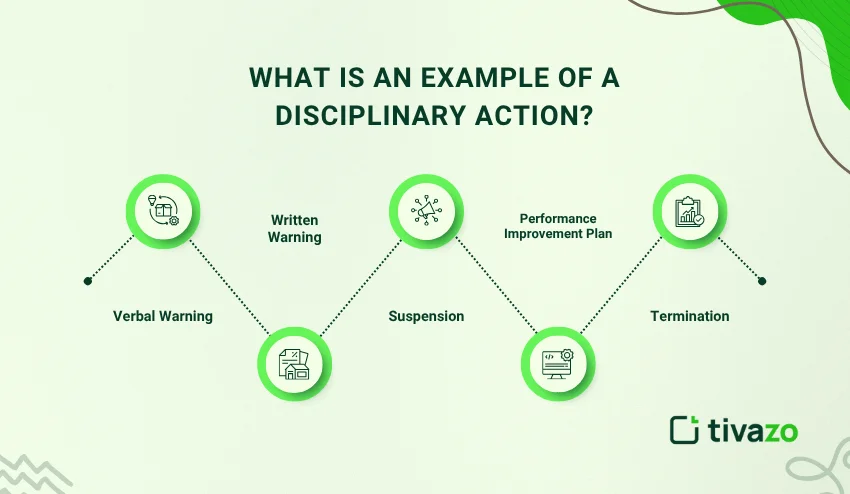
Most Common Types of Disciplinary Actions
The types of disciplinary actions that may be taken will depend on the infraction or performance issue that arises. The table below summarizes the most common types of disciplinary action.
| Type of Disciplinary | Action Description | When Used |
| Verbal Warning | Notice advising the employee to change behavior | Initial small violation |
| Written Warning | Formal written notice of the issue | Repeated violations or medium-level misconduct |
| Final Warning | The informal step before serious consequences | Continue to violate, after a written warning |
| Performance Improvement Plan (PIP) | Structured plan with reasonable expectations | Performance-based issues |
| Suspension | Removed from the workplace for a period of time | Serious misconduct, pending investigation |
| Termination | End of employment for the violation | Severe violation or a repeat of non-compliance |
Using the proper disciplinary action ensures that the employee is treated fairly and that the process will be consistent throughout the organization.
What Causes Employees to Get Written Up at Work?
Employees are generally written up for the following reasons:
- Continual tardiness or absenteeism;
- Not meeting performance objectives;
- Breaking any workplace policies;
- Insubordination;
- Gossip, conflict, or disruptive behavior;
- Violating safety rules;
- Misuse of company property;
- Inappropriate communication in the workplace.
Documentation of written disciplinary action is proof that the employee was informed, counseled, and given a chance to improve.
Does “Disciplinary Action” Always Mean “Fired”?
No. Disciplinary action does not automatically mean termination.
Termination is simply one possible outcome of disciplinary action, usually the outcome of multiple warnings, or for serious and/or unlawful misconduct.
In fact, most disciplinary processes are structured to facilitate improved performance and prevent termination by gradually giving employees one or more opportunities to resolve performance problems.
Disciplinary action generally proceeds in this manner:
– Verbal warning
– Written warning
– Final warning
– PIP or suspension
– Termination
Only when an employee fails to improve does disciplinary action mean termination.
What are the 4 Levels of Discipline?
Most HR departments utilize a 4-step level of discipline:
1. Verbal Warning: This is a simple conversation regarding the behavior in question, and it sets the stage for expected behavior going forward.
2. Written Warning: A written warning is a formal document regarding the behavior in question and the conduct expected to improve.
3. Final Warning or Suspension: A final warning/suspension is a formal disciplinary action that indicates the behavior in question has the potential to lead to termination of employment.
4. Termination: Termination is the last step in the disciplinary process when previous discipline has failed to achieve the desired improvement.
Implementing a 4-level disciplinary process promotes fairness and clarity.
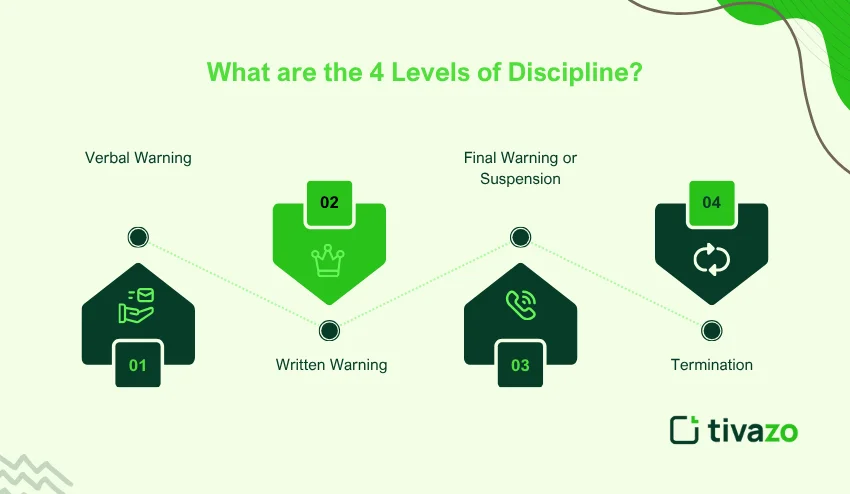
What are the Steps of Disciplinary Action?
Eight out of ten organizations have a five-step process. A five-step process helps provide consistency and structure.
Step 1: Counseling or Coaching
A non-disciplinary conversation to dig into the root cause of the issue.
– Each state has its own laws regarding employment termination.
Step 2: Verbal Warning
A definitive verbal disciplinary process with expectations.
Step 3: Written Warning
A written audit of the issue is documented in the employee’s file.
Step 4: Performance Improvement Plan (PIP) or Suspension
Corrective action is designed to assist and produce changes in an employee.
Step 5: Termination
Termination occurs at the conclusion of any disciplinary attempts if the issue has not been resolved.
The five-step disciplinary action model can be helpful in most corporate HR settings.

Common Mistakes in Disciplinary Action (And How to Avoid Them)
Many HR professionals inadvertently mishandle the disciplinary action process. Here’s how to avoid making a mistake that could be costly to the organization:
1. Inadequate Documentation: You should always document any disciplinary action to mitigate risk of legal recourse.
2. Involvement of Emotions: An individual’s disciplinary action should be a professional action not a personal one.
3. No Recognized Policies: Employees need to be aware of the rules they are expected to abide by.
4. Application that is Inconsistent: Inconsistent treatment of employees could raise claims based on discrimination.
5. Timing of Action: Disciplinary action loses effectiveness based on the amount of time that passes from the incident.

Best Practices for Engaging in Disciplinary Action
Following the below guidelines can help to ensure any disciplinary action is fair:
- Always Engage Proactively in Investigating things
- Focus on the behavior and not the individual
- Communicating and Clarifying Why You Feel The Need to Engage in Disciplinary Action
- Provide opportunity for the employee to express their thoughts
- Clearly define requirements for the employee, which outline what the improvements and specific timeline
- All disciplinary actions should comply with all company policy and all legal guidelines.
- Maintain Confidentiality
- Document Everything
- A properly structured disciplinary action can quickly become a tool that is used for growth instead of punishment.
Conclusion
Disciplinary action refers to the systematic way employers deal with issues in the workplace, including but not limited to, misconduct, workplace policy violations, and/or poor performance. Some common disciplinary action steps include: (1) verbal warning; (2) written warning; (3) suspension; (4) performance improvement plan (PIP); or (5) termination. Each disciplinary step has a distinct role — from correcting behavior early on to documenting for formal reasons and finally separating the employee when necessary. If applied consistently and fairly, disciplinary action can help ensure standards in the workplace are upheld, assist employees in their development, and protect the organization both legally and culturally.
